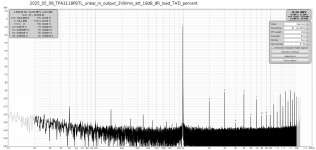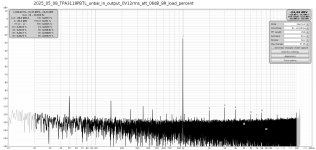Even the board is bigger, so perhaps it may have a better PCB layoutThis one is good, but this one (on the left) is even better..
I've had horrible luck getting that bigger board with the real chip (real as in 32 pin, actual power output, doesn't fail and burn up speakers) lately on ebay. Probably better to buy the parts from a real supplier and a board from someone who's had them made (or make a board).
Meanwhile I did some measurements to verify my actual TPA3118 PBTL mono PCB.
Powered with 4 x 18650 LiIon in series the 1kHz clipping point with 8R load was about 9.5Vrms.
1kHz-THD+N at 8Vrms is 0.018%. Pretty good compared to TI spec of 0.1%. To be fair
The harmonic spectrum looks ugly with hi level distant harmonics.
This is no hi-end reference design - but with a total THD+N < 0.02% @ 8W output not bad at all.
Powered with 4 x 18650 LiIon in series the 1kHz clipping point with 8R load was about 9.5Vrms.
1kHz-THD+N at 8Vrms is 0.018%. Pretty good compared to TI spec of 0.1%. To be fair
- My load is 8R (TI:4R)
- This is PBTL mono - not BTL stereo
- Inductors are much bigger than the TI ones.
The harmonic spectrum looks ugly with hi level distant harmonics.
This is no hi-end reference design - but with a total THD+N < 0.02% @ 8W output not bad at all.
Attachments
Last edited:
The nice thing is that by reducing the output level THD drops continuously until a sweet spot of 0.0077% @120mV/8R = 1,8mW.
Below that point harmonics are buried in noise.
Which tells us that this amp does not produce any crossover distortion as we know it from linear class AB topologies
Below that point harmonics are buried in noise.
Which tells us that this amp does not produce any crossover distortion as we know it from linear class AB topologies
Attachments
Last edited:
TPA gain is set to 20dB. There is a balanced audio front end (AFE) with 6dB gain between signal source and TPA input.
Overall noise was measured 82uV (A-law). TI specifies 65uV without AFE.
Overall noise was measured 82uV (A-law). TI specifies 65uV without AFE.

